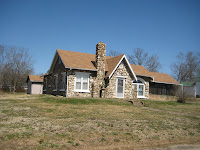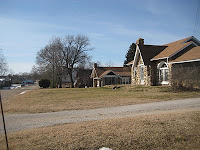Actually, there are rocks everywhere you go in the Ozarks. The soils are shallow, well-drained, and very rocky. Limestone and dolomite underlay half of southern Missouri. These sedimentary or layered rocks are found abundantly in bluffs, creek beds, and on hill sides. Chert is a fine-grained hard rock that occurs within limestone formations. Flint is a dark-colored chert that was used by Indians for arrowheads.
Chert accumulates in abundance in stream beds as gravel and on hillsides within the soil and on the surface. There is so much chert lying around because it is so hard. Water and weather erode it very little. Every square foot of our front lawn contains dozens of pieces of chert.
Ozarkers have always been good at "making-do" with what is available, including rocks. Pre-historic Indians made stone shelters and shrines, mostly from sandstone. Clearing fields for farming by settlers usually resulted in fence-rows of rocks which sometimes grew tall enough to form a fence barrier for cattle.

The pasture edge at right shows an old row of rocks, probably gathered from the pasture. It may never have been tall enough to contain livestock.
The original homes in the Ozarks were log cabins. Most had foundations and chimneys made of local stones.

A more modern use of rocks gathered from fields is the wire basket corner post, as shown on the left.
In the 1920's and 1930's Missouri and Arkansas Ozarkers made use of field stone for home construction. Some builders specialized in constructing stone houses. As you might imagine, these buildings were very sturdy and most persist.
These "three-in-a-row" stone houses (right) are on Third Street in Mountain View, Missouri.
The structures on Third Street must have been developed all in the same era, because there are several stone houses along that street.

This is a different view of that same Third Street stone house (left).
 At the corner of Third and Elm is a stone building that has been a auto repair garage for many years (right). And a block west is the original Mountain View fire station (left below). More modern exteriors were added to the fire station in later years.
At the corner of Third and Elm is a stone building that has been a auto repair garage for many years (right). And a block west is the original Mountain View fire station (left below). More modern exteriors were added to the fire station in later years. 
Native rocks were commonly used for retaining walls (right below).
Many rural school houses were built with native stones.
The building below was the Trask School at one time.
Rural homes were also often constructed using local stones. The house pictured below (center) was built by Earnest LeBaron, my great-grandfather. My grandparents lived there all their lives and my mother grew up in that house. All the rocks were gathered right on the farm.
Rocks are usually a nuisance, especially to farmers. But in the Ozarks, where we have plenty, our rocks sometimes have been quite useful, and beautiful.




No comments:
Post a Comment